Bob McGee 1932 Ford Deuce Roadster HighBoy Hot Rod
Hot rod enthusiast Bruce Meyer owns eight of the world’s most desirable 1932 Ford Deuces’ — and the Bob McGee Roadster is a personal favourite. In this extract from his recent book, Ken Gross explains why it’s so significant.
Studio photography Peter Harholdt.
BOB McGEE ROADSTER
Pebble Beach doyen Bruce Meyer's rarest rod
When someone says “hot rod” to me/ Bruce Meyer says, a ’32 Ford highboy is what comes to my mind. If you went back and looked at my high school book covers, you’d see ’32 roadsters. Lots of them. I drew them all the time. I read Boys Life and Hot Rod Magazine, and dreamed about having a fenderless highboy. That was my world, with a sprinkling of Popular Mechanics here and there. Although I never thought it was attainable, the notion of owning an historic car that was on the cover of Hot Rod meant a lot to me. Bob McGee’s ’32 was the first street roadster on HRM’s cover, back in 1948. That was historically very significant. And the car was beautiful.’ ‘Truthfully/ Bruce admits, I wasn’t totally conversant with Dick Scritchfield [who owned the car after McGee] and his accomplishments. That knowledge came after I bought the car. But the idea of finding what I would consider the “Holy Grail” of early roadsters was always a driving force. I don’t think there is any ’32 Ford highboy roadster that is more definitive than the McGee car. I think it’s the most symbolic roadster of that early period, and arguably for all time.’
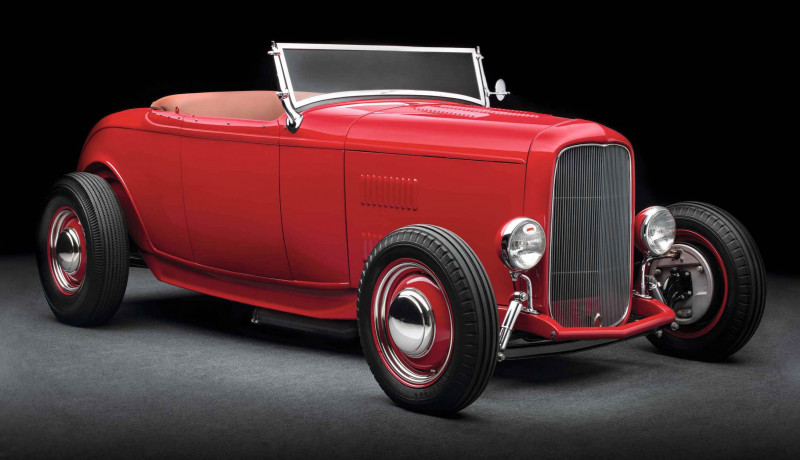
This perfectly proportioned ’32 set a very high standard for the period, thanks to its smartly raked stance, contemporary body and frame modifications, and its high degree of fit and finish. The classic Deuce — the nickname for the 1932-only Model 18, after the ‘2’ in the model year — was already 16 years old in 1948, but McGee’s improvements made it a more contemporary vehicle, including a few unusual exceptions that were never imitated.
THIS ROADSTER WAS ONE OF THE EARLIEST TO FEATURE A MULTITUDE OF ‘FIRSTS’
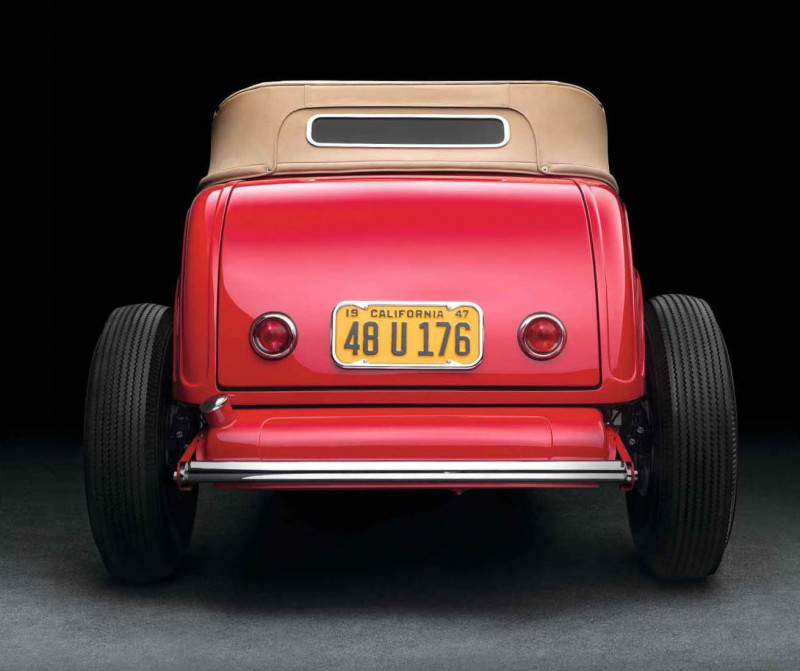
Remember, this was the era when basic function was the norm for most roadsters, especially in California. A guy wanted his hot rod to look cool, but performance at the dry lakes on weekends was the key criterion. Paint was often the last thing considered. Although a few engine accessories and, in rare cases, a front axle and some suspension parts might have been plated, most cars were pretty basic.
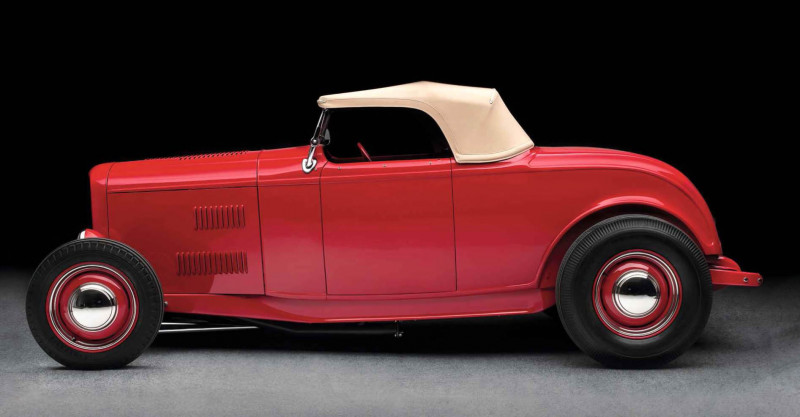
McGee took a different tack, one that would soon be repeated by many car owners who sought feature coverage in the emerging hot rodding magazines. He carefully thought out and planned all the elements of his roadster’s presentation, and employed two of the best metal craftsmen of his day, Jimmy Summers (Hollywood) and Whitey Clayton (Bellflower), to execute his ideas. This roadster was one of the earliest to feature a multitude of ‘firsts’ for a hot rod, such as a filled and peaked front spreader bar in frame horns that were shortened for a neater appearance, hidden door hinges, a filled cowl vent, and a three-piece hood with a clever internal latching system that eschewed external ‘lunch box’ latches. Other notable items included a custom-fabricated dash and an unusual deck-lid treatment that was never imitated. It’s also believed that this was the first use of round ’48 Pontiac tail-lights on a ’32 roadster.
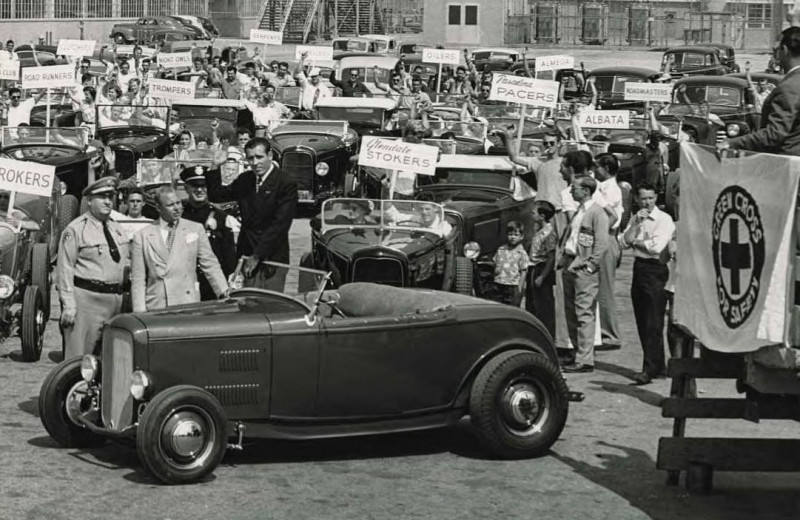
Above and below SCTA president Ak Miller stands in Bob McGee's roadster to swear a road safety pledge; the car's later owner Dick Scritchfield on the salt at Bonneville in 1971, where he set a 167.212mph two-way record.
Aside from appearing on the cover of Hot Rod Magazine’s October 1948 issue, the McGee roadster also played a significant role in a momentous event that began a turnaround in the public perception of hot rods. In the late 1940s, hot rodding appeared to be out of control in Southern California. For every legitimate SCTA dry lakes racer, there were guys who raced illegally on public roads. Reckless driving, high- profile accidents and blatant equipment violations by speed-crazed kids were highlighted in countless blaring newspaper headlines, and in movie newsreels. The bad publicity was making an impact on the sport, and something needed to be done.

On 19 September 1948, the Southern California Timing Association (SCTA) formally joined the National Safety Council (NSC). Some 300 members of the SCTA, representing 36 clubs (some sources say 37), along with about 100 dry lakes racecars, including belly tanks, lakesters and roadsters, and many street machines, gathered at the Lincoln- Mercury assembly plant in May wood, a suburb of Los Angeles. After the hot rodders recited the NSC oath relating to its programme of education in safety, the first car to receive a Green Cross for Safety decal was Bob McGees ’32 Ford roadster. The decal was affixed to McGees windshield by a smiling Ak Miller, president of the SCTA. Doane Spencer’s roadster — also now part of the Bruce Meyer collection — was parked just behind McGee’s car.
As Hot Rod Magazines distribution spread nationwide, so did the word that legitimate hot rodders were safety-conscious young men and women. Along with the later expansion of NHRA-sanctioned drag strips, hot rodding largely lost its reckless image and became respectable. And it all started with the gathering in Maywood and the Bob McGee and Doane Spencer roadsters.
Bob McGees roadster was his daily driver until 1952; it was driven occasionally for two more years, then stored at his parents’ home in Huntington Park, California. He sold the car in 1955 to Dick Hirschberg of Hollywood. The new owner installed a Corvette engine the following year, and built external lakes-type headers for it that were fashioned from 1936 Ford driveshafts; he also painted the roadster a bright yellow. But he wasn’t destined to have the car for very long.
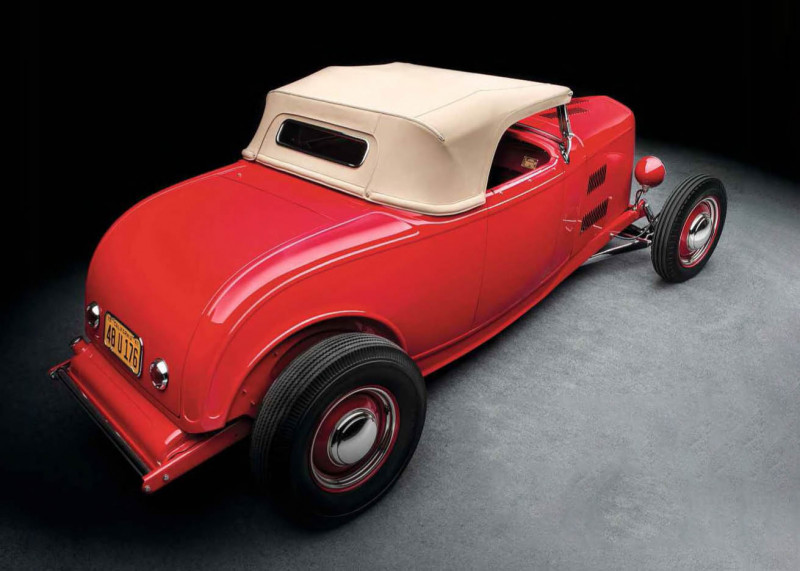
Dick Scritchfield was one of the founders of the Los Angeles Roadsters Club, along with Tony LaMasa and Leroi ‘Tex’ Smith, and he was one of the first NHRA regional advisors. He spotted the ’32 in a service station, and soon traded his OHV Cadillac-powered ’48 Lincoln Continental for it, straight up.
Scritchfield drove the roadster extensively. At first he didn’t make many changes, and the car was paying for itself. As Hollywood producers sought to appeal to the youth market, a series of sensational B-movies with a hot rod or custom car theme became popular. Scritchfield made his roadster available to the movie studios, and it appeared in films such as Hot Rod Gang in 1957 as well as in TV shows including Dobie Gillis, Dragnet, 77 Sunset Strip, The Lawrence Welk Show, and later in Happy Days and Fantasy Island.
The roadster featured in Car Craft magazine after Dean Jeffries applied one of the first metalflake paint jobs. Eddie Martinez redid the interior in pearl white leatherette. The LA Roadsters used its classic silhouette, complete with lakes pipes, for their club logo. By now Scritchfield was working for Petersen Publishing, starting at Car Craft as an associate editor before moving to Rod & Custom as ad manager.
Since he was now an R&C employee, more power was in order for the ’32. A stout 1969 350ci smallblock, built by Dave Carpenter, was installed. The intake was a then-fashionable Weiand tunnel ram, mounting twin four-barrel Holleys; Mallory supplied the ignition system, and the lakes pipes ran through the louvred hood sides, then split off to run through mufflers under the car that exited into twin tailpipes that paralleled the frame horns. A new transmission in the form of a Borg-Warner T-10 was fitted, and a Halibrand quickchange rear-end replaced the old Ford banjo. The roadster was repainted black, with white pinstriped accents. Alloy wheels with non-functional knock-offs replaced the venerable Ford steelies.
Scritchfield brought the ’32 to Bonneville in 1970 and topped 165mph in the C/Street Roadster Class, a remarkable speed for what was basically a street-driven roadster with barn-door aerodynamics.
Along with NHRA Museum curator Greg Sharp, Scritch returned to the salt the following year, ran a best one-way of 168.067mph and backed it up with an impressive 167.212mph average, a record that stood until 1979. Like many hot rods, this car was steadily updated over time, but its original guise was largely preserved.

Above and right McGee roadster now packs a '37 instead of a '32 Ford flathead V8 for driveability but is otherwise as built — and beautifully finished; stance is classic '32 highboy hot rod.
Dick Scritchfield was indelibly identified with this roadster but, after more than 33 years of ownership, he moved to Hawaii in 1989 and it was sold to Brian LaBonge, a nephew of rodding legends Ray Brock and Don Francisco. Brian made very few changes to the car before selling it to noted Arizona collector Bob Everts, who in turn sold the car to Bruce, who kept the then black-and-white roadster as he’d acquired it for several years. Then Bruce decided to have it restored in time for the second historic hot rod class at the Pebble Beach Concours d’Elegance in 1999.
Bruce Meyer recalls: ‘There was never any doubt in my mind about restoring the McGee car to the way it looked on the cover of Hot Rod Magazine. Pete [Bob Petersen] took that picture. We had the Rex Burnett cutaways, and thought we could do a proper restoration. But the car had changed dramatically and we needed to know more about how it was when McGee owned it. My friend Dick Nolind seemed to have known Bob McGee, or his wife, and Nolind told me that McGee had passed away. Sol never gave any thought to chasing him down. But I did let a lot of people know we were going to restore the car.
‘One evening I got a call from a fellow who turned out to be Bob McGee’s son. “I wish I had met your dad,”’ I said. “Can you tell me about the car? I’d like to know more about it.” He said, “Do you want to talk to my dad?” I thought, “Wait a minute, the guy is dead” My eyes rolled back. I thought, “Where is this thing going?”
‘So another guy picks up the phone. He’s real gruff, almost angry. I told him who I was and what I was doing. He turned right around, and he was a really sweet guy. It was Bob McGee himself. Bob was surprised to learn that the car had survived. It was like he was born again. His records, his old pictures — he even had the original pink slip — and his sharp memory were a big help.
I told him we were planning to restore the car just as he’d had it. Then he really started talking about it. I suggested we meet at the So- Cal Speed Shop. At one point after a couple of meetings, he even brought us the SCTA timing tag. One night we had him, Alex [Xydias, founder of the So-Cal Speed Shop] and Wally [Parks, founder of Hot Rod Magazine and, later, the NHRA] together just talking about hot rods. Over time, McGee visited So-Cal’s shop several times to watch the restoration. He couldn’t thank all of us enough. Bob even found us a set of those rare Federal-Mogul cylinder heads for the car. He helped us a lot. Unfortunately, he died before Pebble Beach, which was too bad. It would have been great to have had him there with the car.
‘It was always my idea to return the McGee car to its original form,’ continues Bruce, ‘but it wasn’t an easy decision. Scritchfield had that car for years. And it existed longer as the Scritchfield car than as anything else. It was in more movies, then set the “World’s Fastest Street Roadster” record, and Scritch was the guy who really put that car on the map. But we wanted to take it back to 1948. That Hot Rod Magazine cover really speaks to me.’
Recalling the fine work they had done with the So-Cal Belly Tank, the Doane Spencer ’32 roadster and the Pierson Brothers’ ’34 coupe, Bruce entrusted the roadster to Pete Chapouris and his talented crew. The decision was made to redo the car back to the way it had appeared
on the cover of HRM in 1948, thus erasing all traces of the ’32 in its various Dick Scritchfield iterations.
By all accounts, Scritchfield was understandably not pleased, but historians can only applaud the decision. This writer visited the So-Lal shop during that period and noted that the welds on the Z’d section of the frame seemed pretty crude. I asked Jim 'Jake' Jacobs, who was working there at the time, if they were going to redo the frame. ‘Nope,’ he said. ‘It was good enough to run Bonneville at 168 miles per hour, so it’ll stay the way it is.’
Pete Eastwood, Bill ‘Birdman’ Stewart and Rick LeFever are just a few of the many talented guys who brought the McGee car back. ‘Flathead Mike’ Gilbert built the new engine after a priceless set of Federal-Mogul heads and a correct Bums dual manifold were located. He also rebuilt the early Ford transmission. Tim Beard is credited with the lustrous red finish. The PPG paint was matched to the original colour by Baker Paint in El Monte, California, while expert trimmer Tom Sewell recreated the brown leather upholstery and the padded top, again drawing on Bob McGee’s meticulous records.
When Pete Chapouris was preparing this roadster for the Pebble Beach Concours d’Elegance in 1999, he decided to use a more practical ’37 Ford block, fitted with water pumps, a fan belt and a generator. The Concours regulations clearly specified that selected mechanical updates, if they were possible in the period that the car was built and done with period pieces, might be fitted and approved at the judges’ discretion. This later engine and its accessories made the roadster far more practical to drive.
The So-Cal crew were careful not to over-restore this car. It was done to a high standard originally. They brought it back to that level but avoided any temptation to add plating or other geegaws if they were not present when Bob McGee built it. Bruce debuted the freshly redone ’32 at the 50th Anniversary Grand National Roadster Show, at the Cow Palace in San Francisco in January 1999, to great acclaim.
In August that year, Pebble Beach had nine restored hot rods competing for three awards. It all came down to two cars: Bruce’s restored McGee roadster and the former Dick Flint ’29, owned and restored by Don Orosco. The Flint car won first place, as well as the Dean Batchelor Memorial Trophy, by the narrowest of margins. But at Pebble Beach in 2022, to celebrate the ’32 Ford’s 90th anniversary, the Concours honoured the timeless ‘Deuce’ — and the Bob McGee roadster won First in Class from a field of a dozen historic ’32s.
Winning such a coveted award was a tribute to Bruce Meyer’s and the late Pete Chapouris’ collective abilities to locate, research and restore a vintage hot rod to the highest standard, yet preserve a car substantially as it was first built. The McGee roadster now spends most of its time on display at the Petersen Automotive Museum in Los Angeles. It’s well worth studying.
The text in this feature has been condensed from Deuce! 1932 Ford Hot Rods from the Bruce Meyer Collection, by Ken Gross with photography by Peter Harholdt. It profiles each of the eight significant '32 Ford hot rods owned by legendary enthusiast Bruce Meyer, and is published by The Rodders Journal, ISBN 978 0 578 84320 9, price $39.95. Buy it from The Petersen Store, petersenstore.org, or from Autobooks-Aerobooks, autobooks-aerobooks.com.

Above and right Bob McGee's roadster on the cover of the first Hot Rod Magazine, 1948; McGee and his wife in his previous hot rod; this car was the first '32 to use '48 Pontiac tail-lights.



